
Cristofano Allori was an Italian painter of the late Florentine Mannerist school, painting mostly portraits and religious subjects.
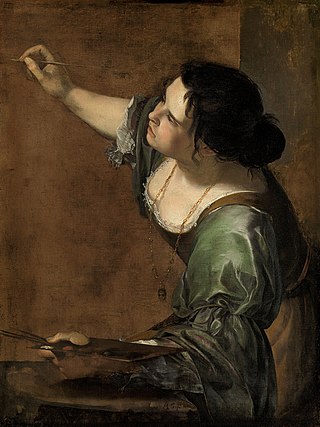
Artemisia Lomi or Artemisia Gentileschi was an Italian Baroque painter. Gentileschi is considered among the most accomplished 17th-century artists, initially working in the style of Caravaggio. She was producing professional work by the age of 15. In an era when women had few opportunities to pursue artistic training or work as professional artists, Gentileschi was the first woman to become a member of the Accademia di Arte del Disegno in Florence and she had an international clientele.

Orazio Lomi Gentileschi (1563–1639) was an Italian painter. Born in Tuscany, he began his career in Rome, painting in a Mannerist style, much of his work consisting of painting the figures within the decorative schemes of other artists.
Painted Lady is a 1997 murder mystery drama starring Helen Mirren, involving art theft. It co-starred Franco Nero, Karl Geary and Iain Glen, and was directed by Julian Jarrold.

Judith Beheading Holofernes is a painting of the biblical episode by Caravaggio, painted in c. 1598–1599 or 1602, in which the widow Judith stayed with the Assyrian general Holofernes in his tent after a banquet then decapitated him after he passed out drunk. The painting was rediscovered in 1950 and is part of the collection of the Galleria Nazionale d'Arte Antica in Rome. The exhibition 'Dentro Caravaggio' Palazzo Reale, Milan, suggests a date of 1602 on account of the use of light underlying sketches not seen in Caravaggio's early work but characteristic of his later works. The exhibition catalogue also cites biographer artist Giovanni Baglione's account that the work was commissioned by Genoa banker Ottavio Costa.

Elisabetta Sirani was an Italian Baroque painter and printmaker who died in unexplained circumstances at the age of 27. She was one of the first women artists in early modern Bologna, who established an academy for other women artists.

Massimo Stanzione was an Italian Baroque painter, mainly active in Naples, where he and his rival Jusepe de Ribera dominated the painting scene for several decades. He was primarily a painter of altarpieces, working in both oils and fresco. His main subject matter was biblical scenes. He also painted portraits and mythological subjects. He had many pupils and followers as his rich color and idealized naturalism had a large influence on other local artists, such as Francesco Solimena. In 1621 Pope Gregory XV gave him the title of Knight of the Golden Spur and Pope Urban VIII made him a knight of St. John around 1624 and a knight of the Order of Christ in 1627. From then on, he liked to sign his works as "EQUES MAXIMUS".

The account of the beheading of Holofernes by Judith is given in the deuterocanonical Book of Judith, and is the subject of many paintings and sculptures from the Renaissance and Baroque periods. In the story, Judith, a beautiful widow, is able to enter the tent of Holofernes because of his desire for her. Holofernes was an Assyrian general who was about to destroy Judith's home, the city of Bethulia. Overcome with drink, he passes out and is decapitated by Judith; his head is taken away in a basket.

Judith Slaying Holofernes is a painting by the Italian early Baroque artist Artemisia Gentileschi, completed in 1612-13 and now at the Museo Capodimonte, Naples, Italy. The picture is considered one of her iconic works. The canvas shows Judith beheading Holofernes. The subject takes an episode from the apocryphal Book of Judith in the Old Testament, which recounts the assassination of the Assyrian general Holofernes by the Israelite heroine Judith. The painting shows the moment when Judith, helped by her maidservant Abra, beheads the general after he has fallen asleep in a drunken stupor. She painted a second version now in the Uffizi, Florence, somewhere between 1613 and 1621.
Judith and Holofernes may refer to:
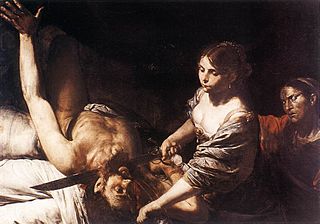
Judith and Holofernes is a painting by the French artist Valentin de Boulogne, from 1626, as a close copy of a similar painting by Artemisia Gentileschi.

Esther Before Ahasuerus is a painting by the 17th-century Italian artist Artemisia Gentileschi. It shows the biblical heroine Esther going before Ahasuerus to beg him to spare her people. The painting is now in the Metropolitan Museum of Art in New York, having been donated to the museum by Elinor Dorrance Ingersoll in 1969. It is one of Gentileschi's lesser known works, but her use of lighting, characterization, and style help in successfully portraying Esther as a biblical heroine as well as the main protagonist of the work.

Judith and her Maidservant is a c. 1615 painting by the Italian baroque artist Artemisia Gentileschi. The painting depicts Judith and her maidservant leaving the scene where they have just beheaded general Holofernes, whose head is in the basket carried by the maidservant. It hangs in the Pitti Palace, Florence.
This is an ongoing bibliography of work related to the Italian baroque painter Artemisia Gentileschi.

Judith and Her Maidservant is one of four paintings by the Italian baroque artist Artemisia Gentileschi that depicts the biblical story of Judith and Holofernes. This particular work, executed in about 1623 to 1625, now hangs in the Detroit Institute of Arts. The narrative is taken from the deuterocanonical Book of Judith, in which Judith seduces and then murders the general Holofernes. This precise moment illustrates the maidservant Abra wrapping the severed head in a bag, moments after the murder, while Judith keeps watch. The other three paintings are now shown in the Museo di Capodimonte in Naples, the Palazzo Pitti in Florence, and the Musée de la Castre in Cannes.
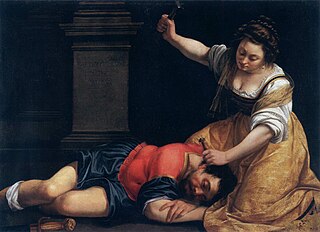
Jael and Sisera is a painting by the Italian Baroque artist Artemisia Gentileschi, executed around 1620.
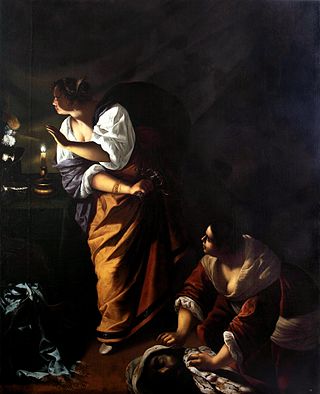
Judith and Her Maidservant is a painting by the Italian baroque artist Artemisia Gentileschi. Executed sometime between 1645 and 1650, it hangs in the Museo di Capodimonte in Naples. The story comes from the deuterocanonical Book of Judith, in which Judith seduces and then assassinates the general Holofernes, who had besieged Judith's town. The exact moment depicted takes place after the murder when her maidservant places the severed head in a bag, while Judith checks around her.
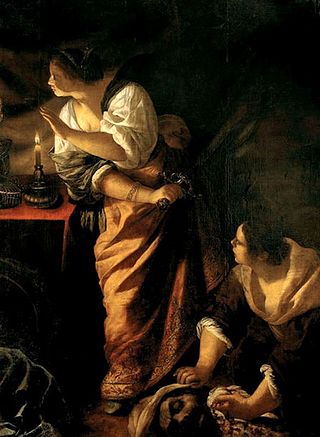
Judith and Her Maidservant is a painting by the Italian baroque artist Artemisia Gentileschi. Executed sometime between 1640 and 1645, it hangs in the Musée de la Castre in Cannes.

Judith Slaying Holofernes c. 1620, now at the Uffizi Gallery in Florence, is the renowned painting by Baroque artist Artemisia Gentileschi depicting the assassination of Holofernes from the apocryphal Book of Judith. When compared to her earlier interpretation from Naples c. 1612, there are subtle but marked improvements to the composition and detailed elements of the work. These differences display the skill of a cultivated Baroque painter, with the adept use of chiaroscuro and realism to express the violent tension between Judith, Abra, and the dying Holofernes.

Mary Magdalene as Melancholy is a 1622–1625 painting by Artemisia Gentileschi, showing Mary Magdalene as a personification of Melancholia. It is now in the Museo Soumaya in Mexico City.

















